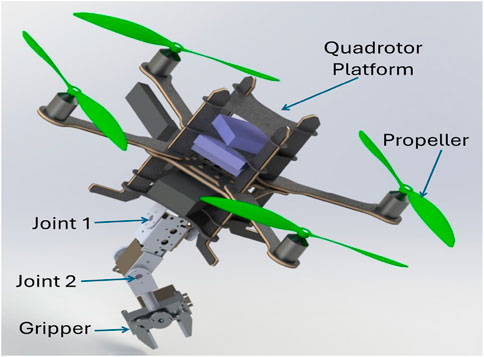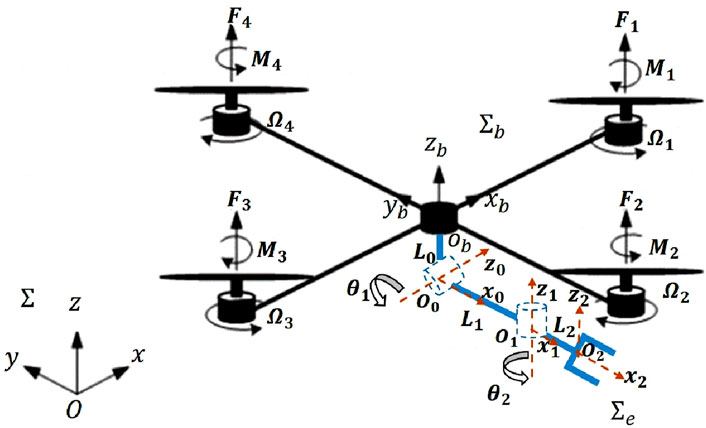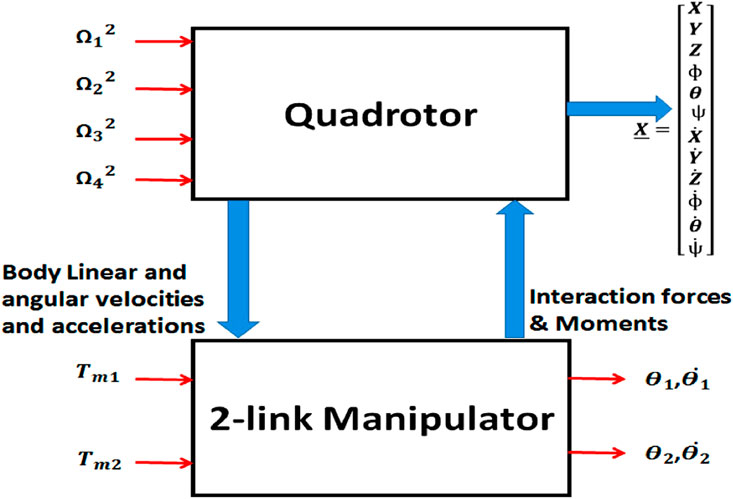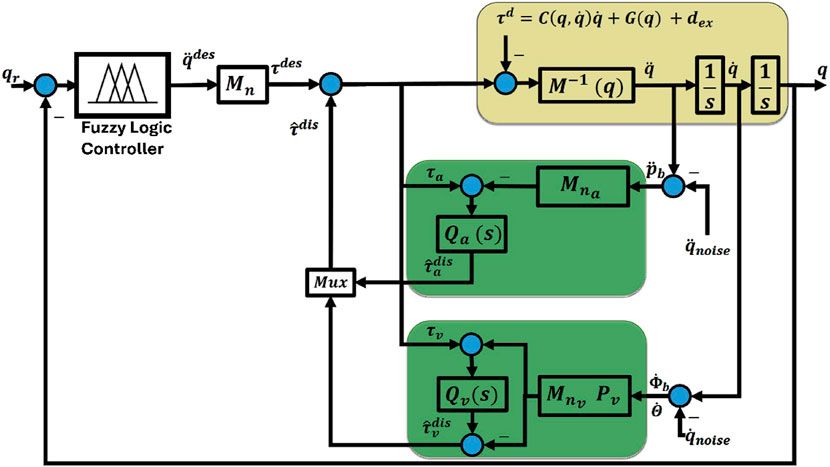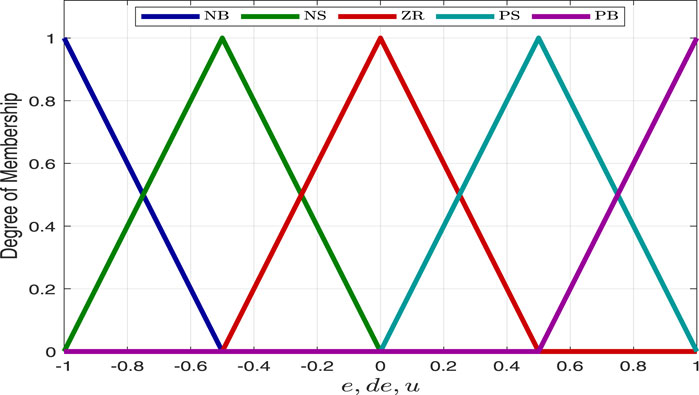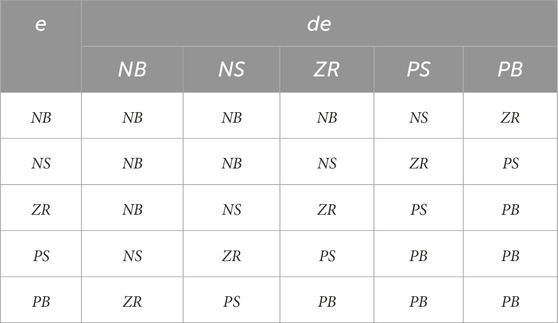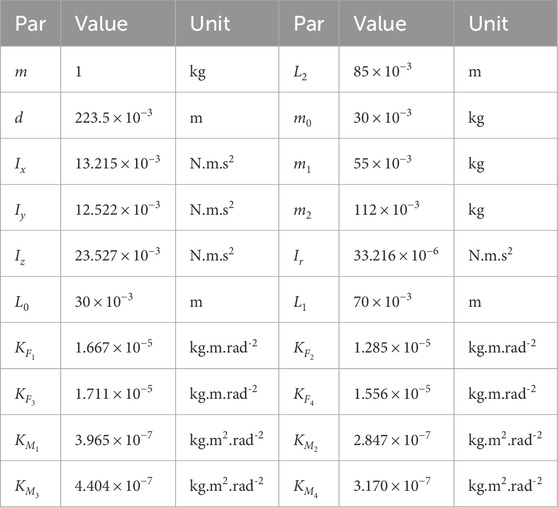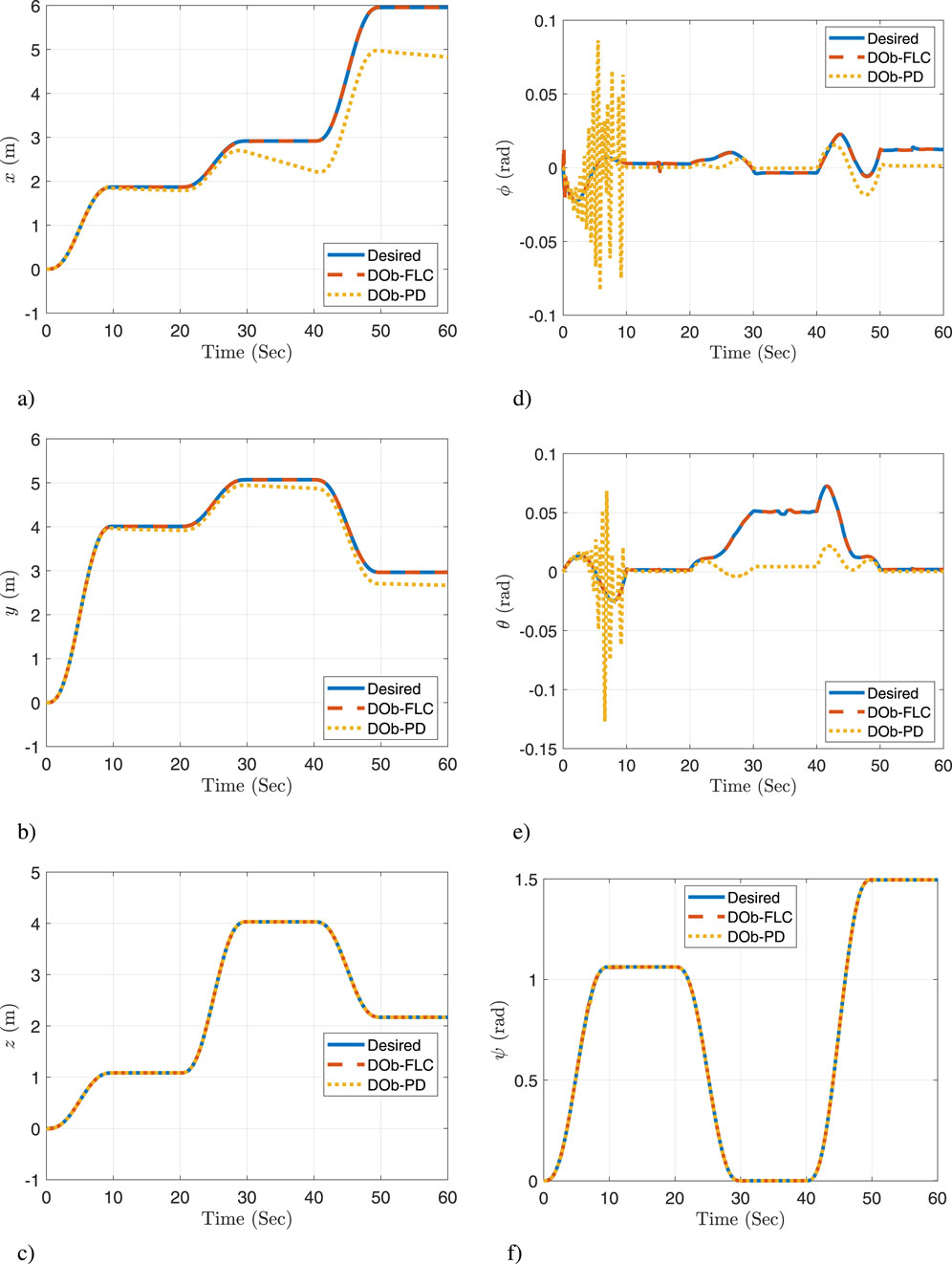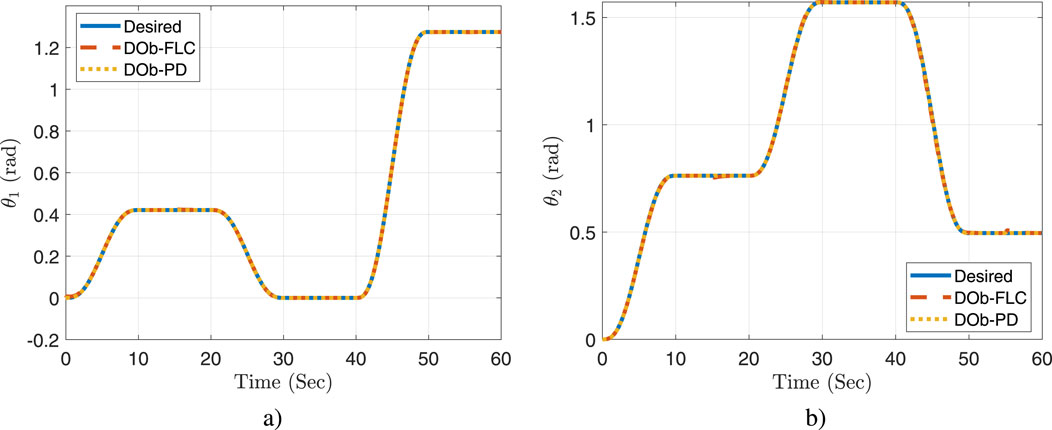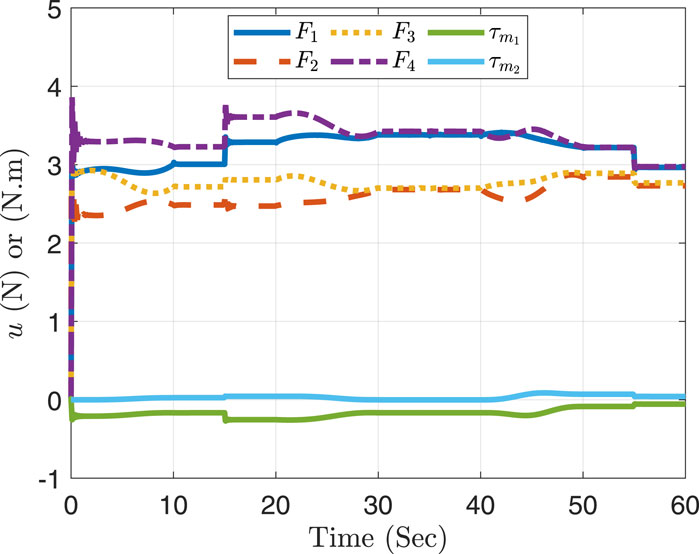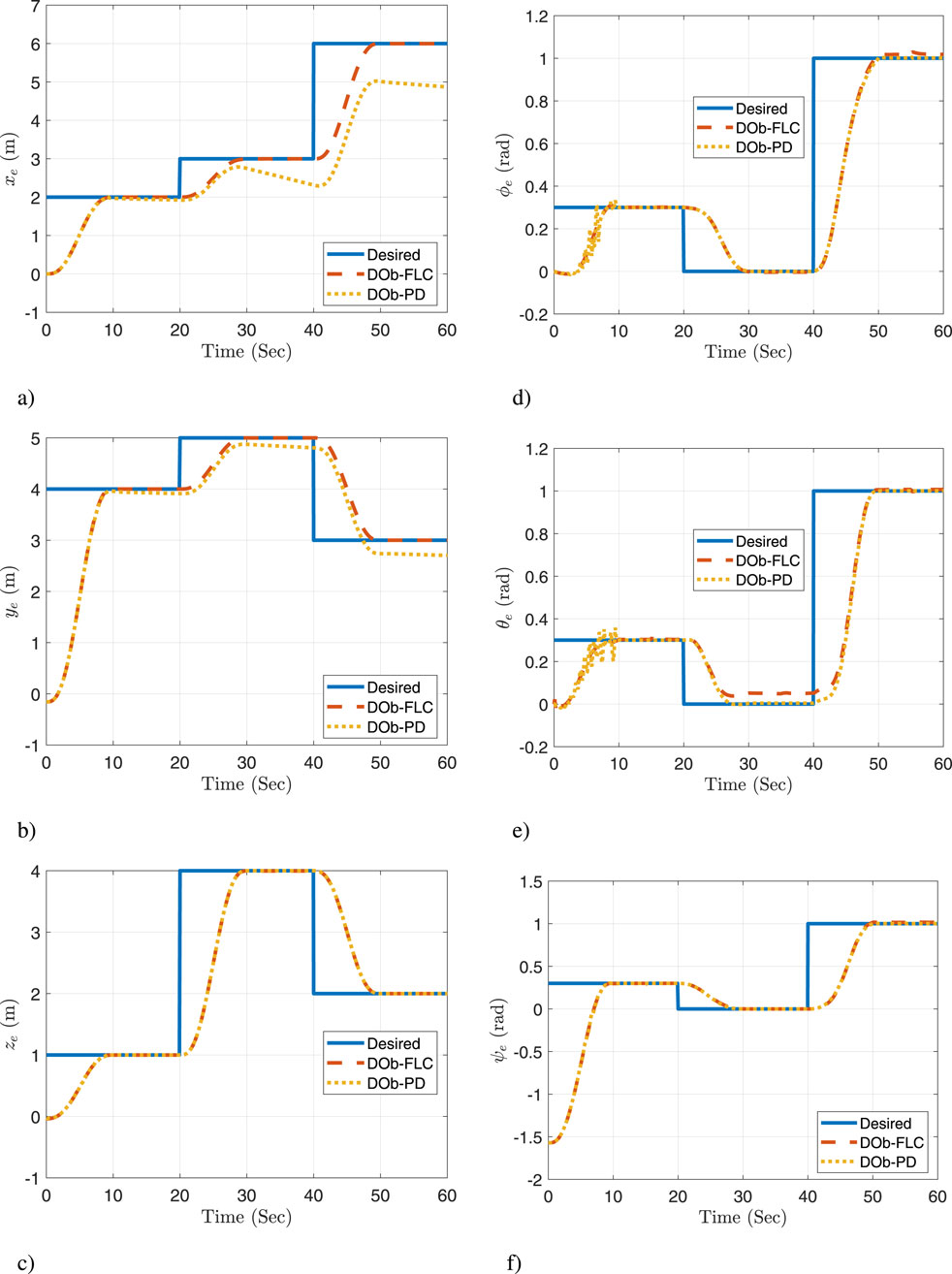- 1Department of Industrial Electronics and Control Engineering, Faculty of Electronic Engineering, Menoufia University, Menouf, Egypt
- 2Center for Scientific Research and Entrepreneurship, Northern Border University, Arar, Saudi Arabia
- 3Cardiff School of technologies, Cardiff Metropolitan University, Cardiff, United Kingdom
Aerial manipulation systems are highly attractive for various applications due to their distinctive features. However, the systems discussed in the literature are constrained by either a restricted number of end-effector degrees of freedom (DOFs) or low payload capability. In our previous research, we mounted a manipulator with a gripper on the underside of a quadrotor to enhance environmental interaction. This paper explores a quadrotor equipped with a 2-DOF manipulator featuring a distinctive topology that allows the end-effector to follow a specified 6-DOF trajectory with the least number of actuators required. An overview of the proposed manipulation system, along with its kinematic and dynamic analysis, is presented. Nevertheless, controlling this system presents significant challenges because of its considerable couplings, nonlinearities, and external disturbances. This paper employs a Disturbance Observer (DOb)-based linearization for an aerial manipulation robot. The DOb-based inner loop is responsible for estimating and compensating nonlinearities and disturbances, which simplifies the control problem into a more straightforward linear control algorithm. Subsequently, a fuzzy logic controller is incorporated into the outer loop to achieve the desired control objectives and closed-loop performance while minimizing computational load. Stability analysis of the proposed controller is introduced. Finally, the system is simulated using MATLAB/SIMULINK, and the results demonstrate tracking accuracy during 6-DOF maneuvers under many kinds of disturbances, with low computational load. The system maintains stability during payload exchanges while respecting all actuator constraints (rotor thrust less than 6 N, joint torques less than 0.7 and 0.4 N.m, respectively). These results demonstrate the effectiveness of the proposed control approach. Also, they show that the proposed controller outperforms the DOb-PD controller’s response.
1 Introduction
Recently, there has been significant interest in aerial manipulators due to their crucial applications in areas that ground robots cannot reach (Khamseh et al., 2018). Quadrotors, with their exceptional mobility, are employed for mobile manipulation, opening new avenues in robotics (Wei-hong et al., 2021; Xilun et al., 2019). These systems are used for various tasks such as inspection, firefighting, maintenance, delivering light items like mail or quick meals in crowded cities, surveillance, rescue operations, transportation in remote locations, demining, and performing tasks in hazardous environments (Orsag et al., 2018; Li et al., 2024).
Numerous studies have been conducted in the field of aerial manipulation (Ollero et al., 2022; Meng et al., 2020; Ruggiero et al., 2018; Wei-hong et al., 2021). However, existing systems in the literature that utilize a gripper are constrained by the limited degrees of freedom (DOF) of the end-effector. Some systems feature a 2-DOF manipulator, which in some configurations prevents the end-effector from following an arbitrary 6-DOF trajectory. Other systems have a manipulator with more than two DOF, which significantly reduces the system’s payload capacity (Orsag et al., 2017). In Fanni and Khalifa (2017), Khalifa et al. (2016a), Khalifa et al. (2024), Khalifa et al. introduce a novel aerial manipulation system comprising a two-link manipulator with two perpendicular revolute joints. One of the quadrotor’s in-plane axes and the first joint’s axis are parallel to each other. The end-effector can achieve any desired position and orientation thanks to this configuration, which eliminates the need for horizontal movement.
Existing control strategies in the literature for aerial manipulation systems rely on highly complex nonlinear controllers that demand significant computational resources. Achieving stable position holding is a major challenge in aerial manipulation. To accomplish this, a robust control system is necessary to handle disturbances, nonlinearities, uncertainties, and couplings. This robustness challenge was addressed in Khalifa et al. (2016b) by employing a control technique based on DOb, which estimates uncertainties and nonlinear terms. By doing so, the robotic system behaves akin to a multi-SISO linear system, allowing the use of standard linear control methods for designing the outer loop controller and ensuring accurate tracking performance.
However, prior research (Li et al., 2016; Sariyildiz and Ohnishi, 2014; Choi et al., 2014; Tian et al., 2024) related to Disturbance Observer (DOb) techniques faces challenges in estimating system velocity or acceleration, particularly due to limitations in sensors that are available for flying robots. Although it is possible to measure angular velocities and linear accelerations using encoders and an Inertial Measurement Unit (IMU), Tomić and Haddadin (2014) suggests a model-based method to estimate external forces for a basic UAV, relying on IMU data. However, this method requires knowledge of dynamic models, disregards certain nonlinearities and dynamics, employs a nonlinear controller, and exclusively addresses external disturbances without taking system dynamics comprehensively into consideration. As a result, this technique is not well-suited for the complex dynamical and kinematic characteristics of the considered aerial manipulator.
In Tutsoy et al. (2023), a reduced-order Thau observer was presented that focusses on uncertain rotational dynamics and achieves accurate fault detection with just a third-order design. However, it should be expanded to include control signal delays, state measurement delays, data loss, and sensor failures. There are many kinds of modern artificial intelligence-based observers. However, the main issue is balancing computational cost, accuracy, and estimation speed. The aerial robotic manipulation system has very fast dynamics. So, an approach with low computational cost is needed. Also, all of these computations must be accomplished onboard to avoid any delay. On the other hand, the computational time in artificial intelligence-based observers will be long.
To address these limitations, the traditional DOb is adapted to be practical and compatible for the aerial manipulation system proposed in Fanni and Khalifa (2017); Khalifa et al. (2016a), Khalifa et al. (2024); Khalifa and Fanni (2017). In the traditional DOb structure, the DOb estimates system disturbances using velocity or acceleration measurements. However, it is commonly known that the quadrotor’s linear accelerations and angular rates may be obtained straight from the IMU. Furthermore, the angular velocities of the joints may be monitored using an encoder. As a result, we propose a hybrid DOb-based controller for our robotic system. In this hybrid DOb-based control, two distinct DOb loops are employed. The first is based on measured accelerations, and the second on measured velocities. Instead of using differentiation (which makes the system more sensitive to noise) or integration (which causes drift), the proposed scheme uses the measured velocity and acceleration directly from the onboard sensors, with no differentiation or integration. As a result, we propose and implement a hybrid observer that uses raw measurements (both measured velocities and accelerations) in our robust motion control scheme.
Our approach involves several key modifications. First, traditional Dob is redesigned, leveraging angular velocities and linear acceleration data directly obtained from the onboard encoders and IMU. By incorporating these measurements, nonlinearities and disturbances are estimated more effectively. Second, the estimated disturbance data is fed back into the system, enabling compensation. As a result, the system’s behavior becomes linear. Third, in the outer loop, we design a fuzzy logic controller optimized for performance. This controller ensures that the system responds as desired to track 6-DOF trajectories in the task space. Lastly, we construct a simulation environment that includes non-idealities, closely emulating real-world conditions. Through this setup, we validate the effectiveness of our proposed technique. By combining these modifications, we enhance the robustness and feasibility of the DOb for complex aerial manipulators.
This paper is structured as follows: Section 2 provides a description of the robot under consideration. Sections 3, 4 review the kinematics and dynamics analysis of the proposed system, respectively. Section 5 formulates and presents the control system design. Section 6 introduces the simulation results obtained using MATLAB/SIMULINK. Finally, Section 7 highlights the main conclusions.
2 Description of the proposed aerial manipulation system
A 3D computer-aided design (CAD) model for the proposed aerial manipulation system is illustrated in Figure 1. The manipulator and the quadrotor itself are the two integral components of this system. Figure 2 offers an illustration that highlights the relevant frames. Notably, these frames define a distinctive topology, enabling the end-effector to achieve arbitrary poses. To maintain consistency, we adhere to the Denavit-Hartenberg (DH) convention for frame transformations (Spong et al., 2020).
Two revolute joints with normal axes are incorporated into the manipulator. Parallel to the quadrotor’s body
Regarding the quadrotor components, we deliberately select specifications to accommodate a payload of 500 g—exceeding the combined weight of the arm and the maximum payload. Our platform of choice is the Asctec Pelican quadrotor, with each rotor capable of generating a maximum thrust force of 6 N. This thrust capacity is determined through a rigorous identification process. The Asctec Pelican quadrotor incorporates an “asctec Autopilot” Flight Control Unit (FCU) and a modular design that facilitates the integration of various components, including position sensors, computer boards, and the manipulator with its associated avionics. The vehicle’s estimated attitude, magnetic orientation, body accelerations, angular velocities are all provided by the IMU that is a part of the FCU. By combining data from the onboard IMU with either laser/ultrasonic range finder or monocular vision data fusion, the system can estimate the quadrotor’s 6-DOF Achtelik et al. (2011).
The manipulator parts are designed, chosen, bought, and assembled with the goal of weighing no more than 200 g overall. The arm can extend to 22 cm and support a 200 g payload. Three DC motors are used: an HS-5485HB (0.70 N.m maximum torque) for the first joint, and another HS-422 (0.40 N.m maximum torque) for the second joint, an HS-422 (0.40 N.m maximum torque) for the gripper. A Motor Driver (SSC) serves as the intermediary interface between the primary control unit and the motors. Remote control commands for the manipulator’s motors are transmitted wirelessly using a PS2 R/C system. The encoder linked to each joint’s motor provides the angular position and speed of the joint. The interface between the onboard computer and the low-level devices (like PS2 wireless receiver, ultrasonic sensor, and motor driver (SSC)) is accomplished utilizing an Arduino Mega 2,560 board.
3 Kinematics analysis
3.1 Forward kinematics
Consider the body-fixed reference frame denoted as
where the ZYX yaw-pitch-roll angles represented by the vector
where
where
Finding the operational task coordinates
3.2 Inverse kinematics
Finding the coordinates of the joint or vehicle space, denoted as
As a function of the end effector variables
Since the objective is to get the inverse kinematics for the reset position,
Using this equation, we can deduce the inverse kinematics for the system. Based on the formulation in Equation 6, the process begins with determining the inverse orientation, which is then succeeded by the calculation of inverse position. The inverse orientation encompasses three cases, outlined as follows.
CASE 1. Assume that neither
Consequently, there are two possible solutions based on the selected sign for
CASE 2. When
We can assign any value to
CASE 3. When
Any value can be assigned to
In both cases two and three, one might set
4 Dynamics analysis
Figure 3 presents a schematic diagram showing the effects of integrating a manipulator with a quadrotor. To analyze the dynamics of the manipulator, the Recursive Newton-Euler method (Tsai, 1999; Fanni and Khalifa, 2017) is employed to formulate the equations governing motion. Given that the quadrotor serves as the manipulator’s base platform, the initial angular and linear accelerations and velocities utilized in the Newton-Euler method are those of the quadrotor represented in its body frame. By considering the link (of length
The quadrotor platform is considered a rigid and symmetrical body. Similarly, each manipulator link is assumed to be rigid. The dynamic behavior of the manipulator is described by
where
where
The parameters in Equations 17–22 are described as follow. The quadrotor’s total mass is denoted by
where
The four rotors’ combined thrust is symbolized by
The control torques around the quadrotor’s body axes
The rotor’s inertia is represented by
The matrix
where
By analyzing the translational dynamic part of Equations 17–19, the following second-order nonholonomic constraint equations can be derived
where
It is important to highlight that the force terms in the equations mentioned previously are function of the states of the system and their derivatives. By substituting the desired trajectories of the other variables into Equations 33, 34, the desired trajectories for
It is worth mentioning that the dynamics of the actuators are much faster than the dynamics of the aerial manipulation system. So, they can be neglected.
Wind dynamics,
Average wind speed is computed by
where
To replicate wind disturbances, calculate the wind force,
where 0.61 is used to convert the wind speed to pressure, and
where
5 Controller design
We wish to accomplish the following objectives by designing the control input
1. System Linearization: The external disturbances and nonlinearities of the system are estimated by utilizing measurement data directly obtained from onboard sensors. This guarantees that the error in estimation,
2. Robust Stability: In spite of uncertainties, external disturbances, and measurement noise, the robotic manipulation system maintains stability and robustness.
3. Trajectory Tracking The deviation in the position of the end-effector tends to diminish to zero as time progresses towards infinity.
Our suggestion for a control strategy is to use a modified DOb and fuzzy logic controller to meet these control objectives. In this approach, system uncertainties, nonlinearities, and external disturbances
5.1 DOb loop
Figure 4 illustrates a block diagram for the DOb controller in the inner loop, which will later facilitate the creation of a robust control system for the intended aerial manipulation system. It is widely known that the IMU can directly capture the quadrotor’s angular rates and linear accelerations. Moreover, joint angular velocities can be obtained using an encoder. Consequently, two separate DOb loops are utilized, one utilizing the measured velocity and the other utilizing the detected acceleration.
In Figure 4, the expression
The system disturbance,
The control input,
where
When the DOb operates flawlessly, it can be presumed that all external and internal disturbances are accurately estimated and mitigated (i.e.,
Given
or more straightforwardly in the acceleration space as
The final step in designing the DOb-based controller is to develop the tracking controller in the DOb outer loop. A fuzzy logic controller for the system described in Equation 43 is selected.
5.2 Fuzzy logic controller
In recent times, fuzzy logic control has emerged as a viable substitute for traditional control algorithms in controlling complex processes (Sridharan, 2022; Rzayev et al., 2023; Baharuddin and Basri, 2023; Lara Alabazares et al., 2021; Hosseinpour and Martynenko, 2022). It offers an effective approach for developing controllers by utilizing heuristic data, making it suitable for various challenging control applications. Additionally, it combines the benefits of conventional controllers with the expertise of human operators. This paper introduces the design of an intelligent controller for an aerial manipulation system, utilizing MATLAB simulation (Simulink).
A fuzzy logic controller is composed of three main components: the Fuzzification module, Inference Engine and Rule Base, and Defuzzification module (Siddique and Siddique, 2014). The process of obtaining a set of fuzzy membership values from a crisp input value is referred to as fuzzification. To facilitate a seamless mapping of the system, the membership functions should have some degree of overlap. Fuzzy rules, crucial for representing knowledge and past experiences in fuzzy logic, are expressed as conditional statements of the form: If
The inference engine involves assessing fuzzy rules to generate an output corresponding to each rule (Kovacic and Bogdan, 2018; Domingos et al., 2016). The output from the fuzzification module, which reflects the degree of membership functions of the input fuzzy sets pertaining to the current state of the process, is compared against each rule’s antecedent to determine a match degree for every rule. This match degree influences the adjustment of the control output variable specified in the rule’s consequent. Composition refers to the integration of the results from all the rules. The result of the combination process is a clipped fuzzy set that signifies the fuzzy values of the control output variable. Following the fuzzy reasoning, we obtain a linguistic output variable that must be converted into a precise crisp value. The goal is to obtain a singular crisp numeric value that most accurately reflects the inferred fuzzy values of the linguistic output variable. Defuzzification effectively translates the output from the fuzzy domain back into the crisp domain.
In Figure 4, fuzzy logic controllers have been developed to manage the position of every joint in the aerial manipulation system. These controllers utilize a similar set of inputs, which include the error
Each fuzzy logic controller employs five symmetric triangular membership functions with linguistic labels of Negative Big
The fuzzy logic controllers share an identical rule base, provided in Table 1, crafted to function as a PD-like fuzzy logic controller. The Mamdani fuzzy inference approach is utilized, employing a min-max operator for aggregation and the center of gravity technique for defuzzification.
5.3 Stability analysis
Control input,
The application of this control law leads to
where
The following may be used to establish the stability of the inner loop:
Consider a Lyapunov function as
This function has the following time derivative
When Equation 48 is substituted with Equation 45,
This proof will use the dynamic equation of motion’s properties Equation 30. These properties are From et al. (2014), Spong et al. (2020):
property 1
property 2
where
When Equation 51 is substituted, Equation 49 becomes
The property Equation 50 yields
Based on the analysis in Sadegh and Horowitz (1990), the analysis is concluded as follows.
After division of Equation 53 by
Multiplying Equation 54 by
with
where
Applying the
Hence
Since
Consequently, Equation 55 becomes
Through simplification, Equation 61 becomes
Let
Lemma 1.
The fuzzy system’s global asymptotic stability is guaranteed, supported by a Lyapunov function proof in Tanaka and Wang (2004).
Lemma 2. (Ioannou and Sun, 2012). Let
where
6 Simulation results
In this section, MATLAB/SIMULINK is utilized to simulate the previously suggested control technique for managing the aerial manipulation system under consideration.
6.1 Simulation environment
To ensure a realistic simulation, we have established the following setup and made specific assumptions:
6.2 Results and discussion
A comparison of the proposed controller (DOb-FLC) to a DOb-PD controller is achieved. For the conducted simulation experiment, the actual response of the quadrotor space coordinate
Additionally, Figure 9 demonstrates that the necessary efforts
Figure 10 illustrates the system’s response in the task space, where forward kinematics is utilized to compute the end effector’s actual position and orientation. This figure highlights the proposed method’s capability to precisely follow the desired 6-DOF end-effector trajectories, even when faced with practical challenges such as measurement noise, wind disturbances, and payload pickup or release. On the other hand, the DOb-PD controller has a steady state error and is less capable of performing good trajectory tracking, especially when faced with practical challenges. Therefore, it can be concluded that the proposed motion control approach is successful in meeting the control objectives.
6.3 Limitations and future extensions
The current study has some limitations that should be acknowledged. First, while the controller is designed for joint-space operation, most practical applications require accurate trajectory tracking in task space (rather than point-to-point) to ensure effective environmental interaction. Second, the control strategy is based on precise onboard positioning systems. Third, while the DOb assures bounded estimating error, this error does not equal zero, which may have an influence on performance in challenging environments that involve significant disturbances.
To address these limitations and expand upon this work, several promising research directions emerge. Future research should focus on experimental validation to evaluate the controller’s performance under realistic situations. The development of task-space control techniques, particularly sensor-based systems for direct environmental interaction, should be a priority. The disturbance estimating technique might be improved with algorithm enhancements targeted at either reaching zero estimate error or drastically reducing its bounds. These extensions would significantly improve the system’s practical applicability and performance.
7 Conclusion
For a quadrotor manipulation system, this paper investigates the challenge of more efficient and reliable robust linearization and control. The description of a new aerial manipulation system, consisting of a quadrotor vehicle and a 2-DOF manipulator that has a unique topology, is introduced. This unique topology enables the system to achieve 6-DOF trajectory tracking with a minimal number of actuators. Kinematics and dynamics analysis are investigated in detail. A modified DOb is utilized to ensure robust response by mitigating disturbances, noise in measurements, and mismatches between the actual plant and its model. In contrast to traditional approaches, the DOb uses measurement data from the encoders and IMU to estimate disturbances. Following this, the outer loop implements a fuzzy logic controller to attain the desired control objectives and closed-loop performance with minimal computational load. Stability analysis of the proposed controller is presented. The suggested control system was carefully tested using MATLAB/SIMULINK simulations. A comparison of the proposed controller to a DOb-PD controller is provided. The results show that the proposed controller outperforms the DOb-PD controller’s response. The results indicate precise trajectory tracking across all 6-DOF, even under diverse disturbances. The proposed controller maintains stable operation during payload handling while working within strict actuator limitations—specifically, rotor thrust remains below 6 N and joint torques remain below 0.7 N m (Joint 1) and 0.4 N m (Joint 2). These data verify the control strategy’s robustness and computational efficiency. In future work, the proposed system will undergo experimental testing.
Data availability statement
The raw data supporting the conclusions of this article will be made available by the authors, without undue reservation.
Author contributions
AlK: Conceptualization, Data curation, Formal Analysis, Funding acquisition, Investigation, Methodology, Project administration, Resources, Software, Supervision, Validation, Visualization, Writing – original draft, Writing – review and editing. SS: Writing – review and editing, Data curation, Supervision, Conceptualization, Formal analysis, Investigation, Funding acquisition, Resources, Software. AhK: Conceptualization, Data curation, Formal Analysis, Funding acquisition, Investigation, Methodology, Project administration, Resources, Software, Supervision, Validation, Visualization, Writing – original draft, Writing – review and editing.
Funding
The author(s) declare that no financial support was received for the research and/or publication of this article.
Acknowledgments
The authors extend their appreciation to Northern Border University, Saudi Arabia, for supporting this work through project number (NBU-CRP-2025-289).
Conflict of interest
The authors declare that the research was conducted in the absence of any commercial or financial relationships that could be construed as a potential conflict of interest.
Generative AI statement
The author(s) declare that no Generative AI was used in the creation of this manuscript.
Publisher’s note
All claims expressed in this article are solely those of the authors and do not necessarily represent those of their affiliated organizations, or those of the publisher, the editors and the reviewers. Any product that may be evaluated in this article, or claim that may be made by its manufacturer, is not guaranteed or endorsed by the publisher.
References
Achtelik, M., Achtelik, M., Weiss, S., and Siegwart, R. (2011). “Onboard imu and monocular vision based control for mavs in unknown in-and outdoor environments,” in 2011 IEEE International Conference on Robotics and Automation, Shanghai, China, 09-13 May 2011 (IEEE), 3056–3063.
Baharuddin, A. D., and Basri, M. A. M. (2023). Self-tuning PID controller for quadcopter using fuzzy logic. Int. J. Robotics Control Syst. 3, 728–748. doi:10.31763/ijrcs.v3i4.1127
Choi, H.-T., Kim, S., Choi, J., Lee, Y., Kim, T.-J., and Lee, J.-W. (2014). “A simplified model based disturbance rejection control for highly accurate positioning of an underwater robot,” in Oceans-St. John’s, St. John's, NL, Canada, 14-19 September 2014 (IEEE), 1–5.
Domingos, D., Camargo, G., and Gomide, F. (2016). Autonomous fuzzy control and navigation of quadcopters. IFAC-PapersOnLine 49, 73–78. doi:10.1016/j.ifacol.2016.07.092
Fanni, M., and Khalifa, A. (2017). A new 6-dof quadrotor manipulation system: design, kinematics, dynamics, and control. IEEE/ASME Trans. Mechatronics 22, 1315–1326. doi:10.1109/tmech.2017.2681179
Hosseinpour, S., and Martynenko, A. (2022). Application of fuzzy logic in drying: a review. Dry. Technol. 40, 797–826. doi:10.1080/07373937.2020.1846192
Hsu, S. (2011). Verifying wind profile equations under hurricane conditions. Open Ocean Eng. J. 4, 60–64. doi:10.2174/1874835x01104010060
Khalifa, A., and Fanni, M. (2017). A new quadrotor manipulation system: modeling and point-to-point task space control. Int. J. Control, Automation Syst. 15, 1434–1446. doi:10.1007/s12555-015-0467-3
Khalifa, A., Fanni, M., and Khalifa, A. (2024). Sensorless contact force estimation and robust impedance control for a quadrotor manipulation system. Sci. Rep. 14, 28772. doi:10.1038/s41598-024-79606-6
Khalifa, A., Fanni, M., and Namerikawa, T. (2016a). “Hybrid acceleration/velocity-based disturbance observer for a quadrotor manipulation system,” in 2016 IEEE Conference on Control Applications (CCA), Buenos Aires, Argentina, 19-22 September 2016 (IEEE), 556–561.
Khalifa, A., Fanni, M., and Namerikawa, T. (2016b). “Mpc and dob-based robust optimal control of a new quadrotor manipulation system,” in 2016 European Control Conference (ECC), Aalborg, Denmark, 29 June 2016 - 01 July 2016 (IEEE), 483–488.
Khamseh, H. B., Janabi-Sharifi, F., and Abdessameud, A. (2018). Aerial manipulation—a literature survey. Robotics Aut. Syst. 107, 221–235. doi:10.1016/j.robot.2018.06.012
Lara Alabazares, D., Rabhi, A., Pegard, C., Torres Garcia, F., and Romero Galvan, G. (2021). Quadrotor uav attitude stabilization using fuzzy robust control. Trans. Inst. Meas. Control 43, 2599–2614. doi:10.1177/01423312211002588
Li, G., Liu, X., and Loianno, G. (2024). Rotortm: a flexible simulator for aerial transportation and manipulation. IEEE Trans. Robotics 40, 831–850. doi:10.1109/tro.2023.3336320
Li, S., Yang, J., Chen, W.-h., and Chen, X. (2016). Disturbance observer-based control: methods and applications. CRC Press.
Meng, X., He, Y., and Han, J. (2020). Survey on aerial manipulator: system, modeling, and control. Robotica 38, 1288–1317. doi:10.1017/s0263574719001450
Ollero, A., Tognon, M., Suarez, A., Lee, D., and Franchi, A. (2022). Past, present, and future of aerial robotic manipulators. IEEE Trans. Robotics 38, 626–645. doi:10.1109/tro.2021.3084395
Orsag, M., Korpela, C., Bogdan, S., and Oh, P. (2017). Dexterous aerial robots—mobile manipulation using unmanned aerial systems. IEEE Trans. Robotics 33, 1453–1466. doi:10.1109/tro.2017.2750693
Ruggiero, F., Lippiello, V., and Ollero, A. (2018). Aerial manipulation: a literature review. IEEE Robotics Automation Lett. 3, 1957–1964. doi:10.1109/lra.2018.2808541
Rzayev, R., Habibbayli, T., and Aliyev, M. (2023). “The use of fuzzy controllers in automatic control systems for quadcopters,” in Proceedings of SAI intelligent systems conference (Springer), 59–74.
Sadegh, N., and Horowitz, R. (1990). Stability and robustness analysis of a class of adaptive controllers for robotic manipulators. Int. J. Robotics Res. 9, 74–92. doi:10.1177/027836499000900305
Sariyildiz, E., and Ohnishi, K. (2014). “A guide to design disturbance observer based motion control systems,” in 2014 International Power Electronics Conference (IPEC-Hiroshima 2014-ECCE-ASIA), Hiroshima, Japan, 18-21 May 2014 (IEEE), 2483–2488.
Slabaugh, G. G. (1999). Computing euler angles from a rotation matrix. Retrieved on August 6, 39–63.
Spong, M. W., Hutchinson, S., and Vidyasagar, M. (2020). Robot modeling and control. John Wiley and Sons.
Sridharan, M. (2022). Short review on various applications of fuzzy logic-based expert systems in the field of solar energy. Int. J. Ambient Energy 43, 5112–5128. doi:10.1080/01430750.2021.1927839
Tanaka, K., and Wang, H. O. (2004). Fuzzy control systems design and analysis: a linear matrix inequality approach. John Wiley and Sons.
Tian, Y., Shi, Y., Shao, X., Hu, Q., Yang, H., and Zhu, Z. H. (2024). Spacecraft proximity operations under motion and input constraints: a learning-based robust optimal control approach. IEEE Trans. Aerosp. Electron. Syst. 60, 7838–7852. doi:10.1109/taes.2024.3419763
Tomić, T., and Haddadin, S. (2014). “A unified framework for external wrench estimation, interaction control and collision reflexes for flying robots,” in 2014 IEEE/RSJ international conference on intelligent robots and systems, Chicago, IL, USA, 14-18 September 2014 (IEEE), 4197–4204.
Tsai, L.-W. (1999). Robot analysis: the mechanics of serial and parallel manipulators. Wiley-Interscience.
Tutsoy, O., Asadi, D., Ahmadi, K., and Nabavi-Chasmi, S.-Y. (2023). Robust reduced order thau observer with the adaptive fault estimator for the unmanned air vehicles. IEEE Trans. Veh. Technol. 72, 1601–1610. doi:10.1109/tvt.2022.3214479
Viktor, V. S., Valery, F. I., Yuri, Z. A., Shapovalov, I., and Beloglazov, D. (2015). Simulation of wind effect on a quadrotor flight. ARPN J. Eng. Appl. Sci. 10, 1535–1538.
Wei-hong, X., Li-jia, C., and Chun-lai, Z. (2021). Review of aerial manipulator and its control. Int. J. Robotics Control Syst. 1, 308–325. doi:10.31763/ijrcs.v1i3.363
Xilun, D., Pin, G., Kun, X., and Yushu, Y. (2019). A review of aerial manipulation of small-scale rotorcraft unmanned robotic systems. Chin. J. Aeronautics 32, 200–214. doi:10.1016/j.cja.2018.05.012
Nomenclature
Keywords: aerial manipulation, dynamics, disturbance observer, fuzzy logic controller, kinematics, quadrotor
Citation: Khalifa A, Shaaban SM and Khalifa A (2025) Hybrid disturbance observer and fuzzy logic controller for a new aerial manipulation system. Front. Robot. AI 12:1528415. doi: 10.3389/frobt.2025.1528415
Received: 14 November 2024; Accepted: 02 June 2025;
Published: 07 July 2025.
Edited by:
Shaoming He, Beijing Institute of Technology, ChinaReviewed by:
Önder Tutsoy, Adana Science and Technology University, TürkiyeBarış Can Yalçın, University of Luxembourg, Luxembourg
Fatemeh Nasr Esfahani, Lancaster University, United Kingdom
Copyright © 2025 Khalifa, Shaaban and Khalifa. This is an open-access article distributed under the terms of the Creative Commons Attribution License (CC BY). The use, distribution or reproduction in other forums is permitted, provided the original author(s) and the copyright owner(s) are credited and that the original publication in this journal is cited, in accordance with accepted academic practice. No use, distribution or reproduction is permitted which does not comply with these terms.
*Correspondence: Alaa Khalifa, YWxhYS5raGFsaWZhQGVsLWVuZy5tZW5vZmlhLmVkdS5lZw==
 Alaa Khalifa
Alaa Khalifa Shaaban M. Shaaban2
Shaaban M. Shaaban2